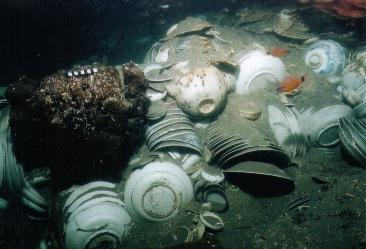Bredenhof (1753)
Silver bar from the Bredenhof shipwreck (http://www.icollector.com/Silver-bar-1740-grams-about-98-5-fine-with-stamps-of-the-Middelburg-chamber-of-the-VOC-Dutch-Ea_i10430672)
VOC Bredenhof was a Dutch East Indiaman transport ship that foundered on a reef 120 miles south of Mozambique and only 13 miles off the South African coast, near the Cape of Good Hope, on the 6th June 1753. It was commercially exploited by treasure-hunters.
More than 12 000 items of Chinese Ceramics were recovered from a shipwreck located about 50 km from Belanakan, West Java in Indonesia. The shipwreck lies at a depth of 58 meters in the Java Sea and measures 50 meters by 20 meters. Archaeologists believe that the blue and white wares originate from the Ming dynasty.
Batam wreck
© World Imaging
The wreck of this small ship is located near the Indonesian Island of Batam, about 100 meters from the coast. It could be of Indonesian origin and used for inter-Island trading in the early 17th century. This wreck is an important source referring to Swatow wares that were produced during the Wanli period (1572-1620 AD).
Ancient settlement and Russian merchant shipwreck
Settlement of Bigah in Absheron: Archaeological explorations along the coast of Azerbaijan have proved that part of the settlement of Bilgah in Absheron is now submerged. Various artefacts, including ceramics, jewellery, domestic items, copperware and faience have been recovered by those underwater explorations.
12th-13th century Wreck
© Area Marina Protetta Porto Cesareo
The wreck of an ancient ship has been found off the coast of Salento, in the southern tip of the Puglia region in Italy, in 2015. The ship is made almost entirely of wood and measures 18 meters by 4,5 meters. A local fisherman made the discovery and notified the authorities who have sent divers to investigate. The wreck lies in the Porto Cesareo Marine Protected Area near to a medieval fishing village.
The Royal Nanhai Shipwreck (1460)
The Royal Nanhai Shipwreck plate (http://www.maritimeasia.ws/exhib01/pages/p009.html)
This wreck was discovered at a depth of 46 meters, 40 nautical miles offshore from Kuantan, West Malaysia.The vessel appears to be 28m long and 7m wide, and is of a typical South China Sea design. This type of vessel, a hybrid that combines Chinese and Southeast Asian elements, has hull planks joined by wooden dowels, and transversal bulkheads. Its cargo includes more than 21,000 ceramics, most of which were Sawankhalok celadon, along with Singburi storage jars and some Chinese brown ware.
The shipwreck of Nan’ao No. 1
Nan’ao No.1 cargo (c Zhangzhuguang)
The shipwreck of Nan’ao No. 1 was discovered near Nan’ao Island off the coast of Shantou City in Guangdong, China.
The Sao Idefonso was a Portuguese flag vessel that sank in 1527 on the Etoile reef of southern Madagascar. Investigation missions have attested to the presence on the wreck site of various artifacts, copper ingots and cannons, so it appears to be one of the very few wrecks in the world bearing witness to the first decades of the Portuguese explorations of the Indian Ocean and of exchanges between Europe and the Far East.
The Portuguese Wanli shipwreck of 1625 was discovered six miles off the east coast of Malaysia after pottery appeared in fishermen’s nets in 1998. The ship was found six years later, loaded with blue and white antique Chinese porcelains belonging to the Ming Dynasty, the ruling dynasty of China from 1368 to 1644. The vessel became known as the Wanli shipwreck after the ceramic recovered was found to have been made in the town of Jingdezhen during the reign of Emperor Wanli (1573-1620).





